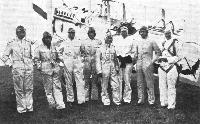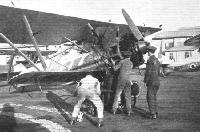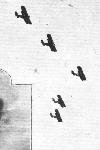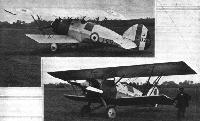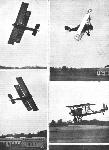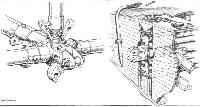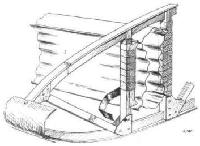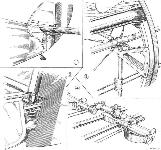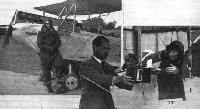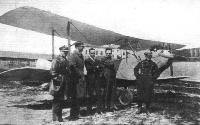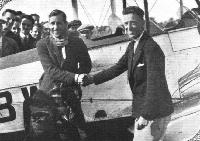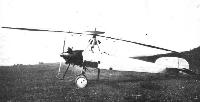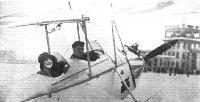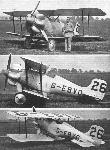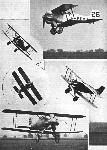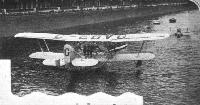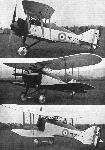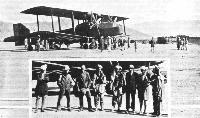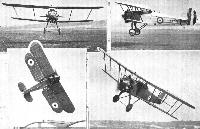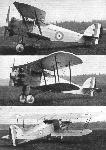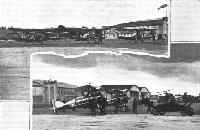Фотографии
-
THE AUXILIARY AIR FORCE IN THE AIR DEFENCE EXERCISES: Our photograph shows some of the Officers of No. 601 (County of London) Bombing Squadron, which is under the command of Squadron Leader Lord Edward Grosvenor. From right to left: Flying-Officer E. D. Whitehead Reid, Flight-Lieut. S. B. Collett, Flying Officer H. N. St. V. Norman, Flying Officer Norman H. Jones, Flying Officer J. J. Parkes, Flight-Lieut. H. N. Thornton (Adjutant), Pilot Officer A. G. Haward and Flying Officer G. J. C. Mahony (Assistant Adjutant).
Самолёты на фотографии: De Havilland D.H.9A - Великобритания - 1918
-
AUXILIARY AIR FORCE MACHINES AT LYMPNE: In the foreground two Avro-Lynx, and behind a number of D.H.9a's.
Самолёты на фотографии: Avro Avro 504N - Великобритания - 1920De Havilland D.H.9A - Великобритания - 1918
-
THE HALTON PAGEANT: Destruction of Desert Stronghold. The bombers (Bristol Fighters and a D.H.9A) bomb the fort.
Самолёты на фотографии: Bristol F.2A/F.2B Fighter - Великобритания - 1916De Havilland D.H.9A - Великобритания - 1918
-
Some A.A.F. "Nurses": Attending the Liberty engine of a D.H.9a. The regular participation by A.A.F. units and the absence of forced landings prove the efficiency of the "amateur" engineers.
Самолёты на фотографии: De Havilland D.H.9A - Великобритания - 1918
-
THE AMSTERDAM AIR TERMINUS: The lower photograph shows the hangars, offices, etc. at the Schiphol aerodrome. The international character of this Dutch airport may be gathered from the machines in front of the buildings, which include a Farman "Jabiru," a three-engined Junkers monoplane, a Fokker monoplane, and a Dornier monoplane. The upper photograph shows the aerodrome restaurant where excellent meals are served, and from which a good view of the aerodrome, machines, etc. is obtained.
Самолёты на фотографии: Dornier Do.B Merkur - Германия - 1925Farman F.120 / F.3X / F.4X Jabiru - Франция - 1923Fokker F.VII / C-2 / F.XIV - Нидерланды - 1924Junkers G 23 / G 24 - Германия - 1924
-
Регистрационный номер: G-EBUT INTERNATIONAL APPRECIATION :This photograph shows a batch of Fokker aeroplanes outside the flying sheds at Schiphol aerodrome, Amsterdam. On the left are four C.V.'s for the Swedish Air Force. Next comes "Mr." Carbery's Universal. Next to that is an F. VII built for the Danish Air Traffic Co. An F. VII-3m for the Nederlandsch-Indische Luchtvaart Maatschappy follows, and in the foreground is an F. VII built for Poland. The C.V.'s and one of the F. VII's are fitted with "Jupiter"engines, while the F. VII-3m has three Armstrong-Siddeley "Lynx" engines. The latter machine is one of a batch to be used in the Dutch East Indies
Самолёты на фотографии: Fokker C.V / C.VI - Нидерланды - 1924Fokker F.VII / C-2 / F.XIV - Нидерланды - 1924Fokker/Atlantic F.9 Universal / F.18 / F.XI Super Universal - США - 1926
-
AN ECHO OF THE SAN FRANCISCO FLIGHT: An aerial view of Eagle Farm Aerodrome, Brisbane, showing the Fokker monoplane "Southern Cross," in which Capt. Kingsford Smith, Mr. C. Ulm, Lieut. H. W. Lyons, and Mr. J. Warner flew from San Francisco to Australia across the Pacific. The photograph was taken immediately after their arrival on June 9.
Самолёты на фотографии: Fokker F.VII / C-2 / F.XIV - Нидерланды - 1924
-
INTO THE CLOUDS: No. 25 (Fighter) Squadron (Armstrong-Whitworth "Siskins") off on the first night patrol of the Air Defence Exercises.
Самолёты на фотографии: Armstrong Whitworth Siskin - Великобритания - 1921
-
Back from a "Strafe": Aircraftmen refuelling an Armstrong-Whitworth "Siskin" after its return from a patrol.
Самолёты на фотографии: Armstrong Whitworth Siskin - Великобритания - 1921
-
NO.32 (FIGHTER) SQUADRON IN ACTION: Above, three Armstrong-Whitworth "Siskins" returning from a patrol. Below, a squadron of "Siskins" ready for the fray.
Самолёты на фотографии: Armstrong Whitworth Siskin - Великобритания - 1921
-
THE HALTON PAGEANT: A flight of "Siskins" machine-gunning the "native tribe."
Самолёты на фотографии: Armstrong Whitworth Siskin - Великобритания - 1921
-
Регистрационный номер: J8027 [3] THE ARMSTRONG.WHITWORTH "STARLING": Three-quarter front and three-quarter rear views. The wing bracing is unusual in that both lift wires run to the front spar.
Самолёты на фотографии: Armstrong Whitworth Starling / A.W.14 - Великобритания - 1927
-
Регистрационный номер: J8027 [3] THE ARMSTRONG WHITWORTH "STARLING": Front View. Note the pronounced rake of the inter-plane struts. The engine is a supercharged Armstrong-Siddeley "Jaguar."
Самолёты на фотографии: Armstrong Whitworth Starling / A.W.14 - Великобритания - 1927
-
Регистрационный номер: J8027 [3] THE ARMSTRONG-WHITWORTH "STARLING" SINGLE-SEATER FIGHTER: The machine in various attitudes of flight, piloted by Mr. Campbell Orde.
Самолёты на фотографии: Armstrong Whitworth Starling / A.W.14 - Великобритания - 1927
-
THE ARMSTRONG-WHITWORTH "STARLING": In order to avoid confusion it has been necessary to omit, in this side elevation, a good deal of the equipment, but sufficent detail has been retained to show the main structure. An unusual feature of the machine is that the wing section is a symmetrical one (R.A.F. 30). It should also be noted that the main lift wires both go to the front spar.
Самолёты на фотографии: Armstrong Whitworth Starling / A.W.14 - Великобритания - 1927
-
THE ARMSTRONG-WHITWORTH "STARLING": Sketches showing attachment of lower wing to fuselage, the fuselage joint being on the left and the wing root on the right.
Самолёты на фотографии: Armstrong Whitworth Starling / A.W.14 - Великобритания - 1927
-
The wing ribs of the Armstrong-Whitworth "Starling" are of wood. Their construction is indicated in this sketch, as well as the method of fastening them to the steel spars.
Самолёты на фотографии: Armstrong Whitworth Starling / A.W.14 - Великобритания - 1927
-
THE ARMSTRONG-WHITWORTH "STARLING": Use is made of an anti-vibration device which prevents the anti-lift wires from going slack. The inset shows a neat type of "skewer" used for the fastening of cowls, inspection doors, etc.
Самолёты на фотографии: Armstrong Whitworth Starling / A.W.14 - Великобритания - 1927
-
THE ARMSTRONG-WHITWORTH "STARLING": Some constructional details. (1) shows the stern of tne fuselage, with elevator controls, tail skid, etc. Details of the fuselage construction are shown in (2). The main structure is tubular, but fairings are added to this, which are in the form of channel section hoops carrying crinkled strip stringers. The trunnion arrangement of the tail for trimming is shown in (3), and the adjustable foot bar in (4). Pivoting in the central hexagonal fitting, the foot bar can be fixed in the position shown, or in the fully forward, or in a number of intermediate positions.
Самолёты на фотографии: Armstrong Whitworth Starling / A.W.14 - Великобритания - 1927
-
Armstrong Whitworth "Starling" Armstrong Siddeley "Jaguar" (Supercharged Engine)
Самолёты на фотографии: Armstrong Whitworth Starling / A.W.14 - Великобритания - 1927
-
THE HALTON PAGEANT: Finish of the Light Aeroplane Race. First, Capt. Stack ("Cirrus-Moth"), second, Miss Spooner ("Cirrus-Moth"), third, Miss O'Brien ("Cirrus-Moth").
Самолёты на фотографии: De Havilland Moth / D.H.60 - Великобритания - 1925
-
Capt. H. Broad bringing down the Gipsy-Moth at Stag Lane aerodrome at 5.30 p.m. on August 17 after a whole day in the air. There was sufficient petrol left for a further 4-hour flight out of the original 80 gallons carried.
Самолёты на фотографии: De Havilland Moth / D.H.60 - Великобритания - 1925
-
A NEW BRITISH WORLD'S RECORD: On July 25 Capt. Geoffrey de Havilland established a new world's altitude record for the 2-seater light 'plane class, when, accompanied by his wife, he ascended from Stag Lane in a standard "Moth" fitted with the new 85-100 h.p. "Gipsy" engine, and reached an altitude (subject to correction) of 21,000 ft. Capt. de Havilland is seen (on the left) standing by the machine just before the start, and on the right, Mrs. de Havilland is seen receiving the sealed barograph.
Самолёты на фотографии: De Havilland Moth / D.H.60 - Великобритания - 1925
-
Mr. Leslie Irvin (in overalls) after landing at Warsaw, Poland, following a recent flight from England in his own D.H. "Moth." With him are (left to right) Capitaine Wroniecki, Commandant Willmann, Flt.-Lt. H. O. Long, and Col. Abzoltowski.
Самолёты на фотографии: De Havilland Moth / D.H.60 - Великобритания - 1925
-
Congratulations: Capt. H. Broad, on the ground again at Stag Lane aerodrome, after a 24-hour record in the air with the Gipsy-Moth, receives congratulations from Capt. W. L. Hope, who won the King's Cup this year on the same type of machine.
Самолёты на фотографии: De Havilland Moth / D.H.60 - Великобритания - 1925
-
The Gipsy-Moth, piloted by Capt. H. Broad, taxying in on August 17, 24 hours after taking off from the same spot to establish a record duration flight for light aeroplanes.
Самолёты на фотографии: De Havilland Moth / D.H.60 - Великобритания - 1925
-
Регистрационный номер: G-EBYK THE HALTON PAGEANT: Capt. Broad taking off in his cleaned-up King's Cup "Gipsy-Moth."
Самолёты на фотографии: De Havilland Moth / D.H.60 - Великобритания - 1925
-
Cierva Autogiro "C.8.L.2" (Armstrong-Siddeley "Lynx" 180 h.p.), which recently toured Great Britain.
Самолёты на фотографии: Cierva/Avro C.8 / C.9 - Великобритания - 1926
-
IN THE CAMP OF THE "ENEMY": "Fairey Foxes" of No. 12 Squadron warming up their engines at Andover, and, above, taking off in formation in the rain.
Самолёты на фотографии: Fairey Fox - Великобритания - 1925
-
"Bombing-up": Aircraftsmen mounting one of the bombs on a Fairey "Fox."
Самолёты на фотографии: Fairey Fox - Великобритания - 1925
-
Регистрационный номер: J9084 LANDPLANE AND SEAPLANE TOO: These two photographs show the Westland "Wapiti," Bristol "Jupiter VI" engine, fitted with floats. The two types of undercarriage are interchangeable. The machine has recently passed its tests as a seaplane at Felixstowe, and is reported to handle very well indeed.
Самолёты на фотографии: Westland Wapiti - Великобритания - 1927
-
"THEORETICAL ENEMIES" LEAVING THEIR BASE: Two of the Hawker "Horsleys" of No. 100 Squadron leaving Andover on the first day of the Manoeuvres preparatory to attacking London.
Самолёты на фотографии: Hawker Horsley / Dantorp - Великобритания - 1925
-
Mrs. Hilton Philipson, M.P., taking off from Croydon Aerodrome in an Avro "Avian." She is thought to be the first lady M.P. to have flown.
Самолёты на фотографии: Avro Avian / Type 594/616 - Великобритания - 1926
-
Регистрационный номер: M-CDAD AVIANS "EX WORKS." - A batch of Cirrus-Avians at Woodford ready for collection. It will be seen that the one nearest the camera bears Spanish registration marks. The Spanish agent finds it quicker and cheaper to fly his Avians to Spain than to ship them.
Самолёты на фотографии: Avro Avian / Type 594/616 - Великобритания - 1926
-
Регистрационный номер: G-EBVO [2] THE BLACKBURN "LINCOCK": A light single-seater fighter, fitted with Armstrong-Siddeley "Lynx" engine. Note the "helmets" over the cylinders. The figure of the pilot (Capt. Blake) standing next to the machine gives a good idea of the smallness of the "Lincock."
Самолёты на фотографии: Blackburn Lincock / F.2 - Великобритания - 1928
-
Регистрационный номер: G-EBVO [2] A LIGHT FIGHTER WITH HIGH PERFORMANCE: The Blackburn "Lincock," Armstrong-Siddeley "Lynx" engine, in flight, piloted by Capt. Blake. In spite of the relatively low power the machine has an impressive performance. It is also reported to be exceptionally nice to fly.
Самолёты на фотографии: Blackburn Lincock / F.2 - Великобритания - 1928
-
Регистрационный номер: G-EBTB When a customer demanded a Morris Six Coupe immediately Mr. A. G. Wilson, of Leeds, flew to Oxford in this Blackburn "Bluebird" from Sherburn, Yorkshire, and delivered the car in Leeds by the evening, earlier than promised.
Самолёты на фотографии: Blackburn Bluebird / L.1 - Великобритания - 1924
-
Регистрационный номер: G-EBSW [2], G-EBVG [2] One of the sights of London last week was the all-metal Short "Calcutta" flying-boat of Imperial Airways, which, piloted by Mr. Lankester Parker, and with Mr. Oswald Short on board, flew from Rochester on August 1 and alighted on the Thames above Lambeth Bridge. It was moored opposite the Houses of Parliament, and later a large number of members, including Sir Samuel Hoare, were taken out to the flying-boat and made a thorough inspection of this latest example of modern transport. Large crowds had gathered on the embankment and the bridge to see the "Calcutta," which continued to attract sightseers during the several days it was moored on the water. Shortly after its arrival at Westminster, Col. the Master of Sempill arrived on a Blackburn "Bluebird" seaplane, which provided a striking contrast when moored next to the "Calcutta" as shown in our illustration.
Самолёты на фотографии: Blackburn Bluebird / L.1 - Великобритания - 1924Short Calcutta / Rangoon / S.8 - Великобритания - 1928
-
Регистрационный номер: G-EBSW [2] A "close-up" of the "Bluebird."
Самолёты на фотографии: Blackburn Bluebird / L.1 - Великобритания - 1924
-
Регистрационный номер: NZ503 GLOSTER "GREBES" FOR NEW ZEALAND: These three photographs show the two-seater Gloster "Grebe." Armstrong-Siddeley "Jaguar" engine, of which a batch has been ordered by the New Zealand Government.
This two-seat Grebe, NZ503, was delivered to the New Zealand Permanent Air Force and assembled in 1928. The aircraft remained in NZPAF service until written off during an aerobatic display at Hornsby on August 8, 1932.Самолёты на фотографии: Gloster Grebe - Великобритания - 1923
-
A HUSTLER: One of the Gloster "Grebes" built for the New Zealand Air Force is here seen in flight, piloted by Capt. H. Saint.
Самолёты на фотографии: Gloster Grebe - Великобритания - 1923
-
Регистрационный номер: J7745 A HANDLEY PAGE IN INDIA: These two views were taken at Arawali, a landing ground on the North-west Frontier of India, about 3,700 ft. above sea-level. They show a Handley Page "Hinaidi," fitted with two Bristol "Jupiters" and (below) some of its crew with the armed native tribesmen who guard the aerodrome.
Самолёты на фотографии: Handley Page Hyderabad/H.P.24 / Hinaidi/H.P.33 / Clive/H.P.35 - Великобритания - 1923
-
Регистрационный номер: G-EBVG [2] The picture shows another view of the " Calcutta" with "Big Ben" in the background
Самолёты на фотографии: Short Calcutta / Rangoon / S.8 - Великобритания - 1928
-
SCALE EFFECT! Two views of the Fairey III F (Napier "Lion"), one being of a scale model, and the other being of one of the actual machines recently supplied to the Irish Free State Air Force. Which is which, we leave to our readers to guess. (N.B. - No prize given.)
Самолёты на фотографии: Fairey Fairey IIIF - Великобритания - 1926
-
The Bach "Air Yacht": Three-quarter front view of an American three-engined commercial monoplane. The centre engine is a nine-cylindered, 250 h.p. Waterman air-cooled radial, while the wing engines are five-cylindered, 100 h.p. Kinner radials.
Самолёты на фотографии: Bach Air Yacht - США - 1927
-
THE BACH "AIR YACHT": Side view. The cabin accommodates eight passengers.
Самолёты на фотографии: Bach Air Yacht - США - 1927
-
Bach Air Yacht 250 hp. "Waterman" (centre) and 2 - 100 hp. "Kinner" (wing) Engines
Самолёты на фотографии: Bach Air Yacht - США - 1927
-
Регистрационный номер: H-NAER ECONOMICAL AVIATION: The Koolhoven F. H. 41, although fitted with a Siemens engine of 50 h.p. only, carries pilot and two passengers. The machine is built mainly of wood, both fuselage and wing being covered with three ply. On the right the machine is seen in flight, piloted by M. Van Vloten.
Самолёты на фотографии: Koolhoven FK-41 - Нидерланды - 1928
-
Регистрационный номер: J8776 [2] THE HAWKER "HAWFINCH" IN FLIGHT: These four views from various angles give some idea of the manoeuvrability of the machine. The front view is a very remarkable picture, and shows good "team work" between our photographer and Mr. Bulman, Hawker's Chief Test Pilot.
Самолёты на фотографии: Hawker Heron / Hornbill / Hawfinch / Hoopoe - Великобритания - 1925
-
Регистрационный номер: J8776 [2] A MODERN SINGLE-SEATER FIGHTER: The Hawker "Hawfinch," Bristol Series VII "Jupiter" engine, incorporates several unusual features. In spite of its diminutive size, its biplane wings show two-bay bracing. The small lower plane, pronounced stagger, and low placing of the top plane result in an excellent view, coupled with a very rigid wing structure. These three views give a good idea of the general lay-out.
Самолёты на фотографии: Hawker Heron / Hornbill / Hawfinch / Hoopoe - Великобритания - 1925
-
WINNIPEG FLYING CLUB: Left, Mrs. J. Bracken, who christened the first D.H. "Moth" belonging to the Winnipeg Club, landing from the machine after a flight with Mr. Michael de Blicquy, and receiving a bouquet from the Chairman, Mr. Roy S. Parkhill, and right, Mr. C. W. ("Speed") Holman, operating manager of North Western Airways, Inc. St. Pauls, Minn., thrilled the crowd with his flying at the opening of the Winnipeg Club. He is noted for his record loops.
Самолёты на фотографии: De Havilland Genet Moth - Великобритания - 1926
-
Регистрационный номер: G-AAAA THE LATEST TYPE "GIPSY MOTH": The first of what may be termed the standard "Gipsy Moth" has been bought by Captain Geoffrey de Havilland, who is at present on holiday in the machine, accompanied by Mrs. de Havilland. Features of the new type are the neat cowling of the D.H. "Gipsy" engine, the new type of undercarriage, which has a wide track and a long travel, and the comfort of the cockpits, as well as a very large luggage compartment. The long exhaust pipe makes for very silent running.
Самолёты на фотографии: De Havilland Gipsy Moth / Moth X - Великобритания - 1928
-
Регистрационный номер: J8082 THE AIR DEFENCE EXERCISES: With No. 23 (Fighter) Squadron, Kenley. The top picture shows a few of the squadron's "Gamecocks" off duty for a few hours, while below is seen a scene immediately after an alarm was received. The Hucks starter got busy without delay.
Самолёты на фотографии: Gloster Gamecock - Великобритания - 1925
Статьи
- Flight
